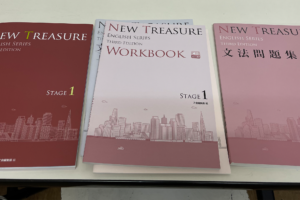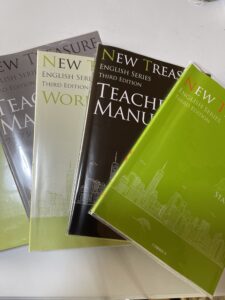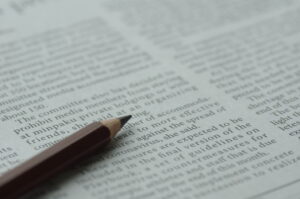奈良学園前と西宮夙川にある英語専門塾です。多くの生徒がニュートレジャーやプログレスなどの教科書を使っています。教室ではオリジナルのプリントを作って対応しております。その中から少しずつアップしていきます。
ニュートレジャー ステージ2 レッスン9 リードの和訳です。
自習勉強にお役立てください。
奈
p.128 【Lesson 9】 Thank You, Kaka Murad
On December 7, 2019, the president of Afghanistan and ❶ soldiers ( ) their uniforms were at the airport in Kabul. The men walked slowly toward a Japanese plane and the president was ❷at the ( ) front. On their shoulders, they were carrying a coffin. There was an Afghan flag on it. ❸( ) ( ) the body of Nakamura Tetsu. Who was Nakamura Tetsu, and why was the president of Afghanistan carrying his body? ❹Let’s ( ) ( ) about him and his life.
ありがとう,カカ・ムラド
**①**
2019年12月7日,アフガニスタンの大統領と❶軍服を着た兵士たちがカブールの空港にいました。男たちはゆっくりと日本の航空機に向かって歩き,大統領は❷まさにその先頭にいました。肩の上に彼らは棺を載せて運んでいました。その上にはアフガニスタンの旗が掛けられていました。❸その中には中村哲さんの遺体が納められていました。中村哲さんとは誰で,なぜ彼の遺体をアフガニスタンの大統領が運んでいたのでしょう。彼と彼の人生について❹調べてみましょう。
p.129
②
Nakamura Tetsu was born in Fukuoka in 1946, just after the end of World War II. After graduating from Kyushu University in 1973, he became a doctor. In 1984, he went to Pakistan as a medical volunteer. ❶ There Dr. Nakamura treated patients ( ) leprosy. ❷His hospital ( ) the border of Afghanistan was also visited by many Afghan refugees. ❸They were living in camps in Pakistan ( ) ( ) the war ( ) their home country.
Dr. Nakamura continued to work in both Pakistan and Afghanistan as a doctor. His medical group was called the Peace (Japan) Medical Services (PMS). They sent many doctors from their base hospital ❹ to help people ( ) areas ( ) ( ) medical care. ❺( ) ( ) their hard work, many lives were saved. ❻( ) ( ) ( ), however, Dr. Nakamura realized that many people were getting sick because of poverty. ❼ They didn’t have ( ) ( ) ( ) ( ) or ( ) ( ) ( ) ( ). Dr. Nakamura’s medicine couldn’t solve those problems. He knew he needed to start helping people in a different way. But what could he do?
**②**
中村哲さんは第二次世界大戦終戦直後の1946年,福岡で生まれました。九州大学を1973年に卒業後,医師になりました。1984年,彼は医療ボランティアとしてパキスタンに渡りました。❶そこで中村医師はハンセン病患者の治療に当たりました。❷アフガニスタンとの国境の近くにあった彼の病院には,多くのアフガニスタン人の難民も訪れました。❸彼らは祖国での戦争のために,パキスタンの難民キャンプで生活していたのです。
中村医師は医師としてパキスタンとアフガニスタンの両国で仕事を続けました。彼の医療グループは平和医療団・日本(PMS)と呼ばれました。❹彼らはほとんど医療を受けることができない地域の人々を助けるために,基幹病院から多くの医師を派遣しました。彼らの懸命な働きの❺おかげで,多くの命が救われました。しかしながら,❻徐々に中村医師は,貧困のために多くの人々が病気になっていることがわかってきました。❼彼らには十分な食料もきれいな飲料水もありませんでした。中村医師の治療では,それらの問題を解決することはできませんでした。彼は,別の方法で人々を援助し始める必要があることを知ったのです。でも,彼に何ができたでしょうか。
- 130
In 2000, the situation became worse. There was a major drought in Afghanistan. People became very sick and many children died because they couldn’t get clean water and food. Therefore, Dr. Nakamura and his team, ❶( ) ( ) the local villagers and volunteers from Japan, started digging wells to provide drinking water. After completing 1,600 wells, they began to build a canal to provide water for the fields. At first, they had no money for expensive machines to dig the ground, so everyone worked ❷( ) ( ). ❸( ) ( ) ( ), they were able to get heavy machines, and started using them. But still, they had to ❹( ) many ( ).
**③**
2000年に状況は悪化しました。アフガニスタンでは深刻な干ばつが起こりました。清浄な水と食料を手に入れられなかったため,人々は重い病気にかかり,多くの子供たちが亡くなりました。そのため,中村医師と彼のチームは,地元の村民と日本からのボランティアと❶一緒に,飲料水を供給する井戸の掘削を始めました。1,600本の井戸を完成させたあと,畑に水を供給する用水路の建設を始めました。当初は地面を掘る高価な機械を買う資金がなかったため,全員❷手作業で行いました。❸しばらくして重機を手に入れることができ,それを使い始めました。しかしそれでもなお,彼らは❹多くの困難を克服しなければなりませんでした。
- 131
Finally in 2010, ❶ a 25 ( ) canal was completed! This and 8 other canals are now used to help more than 650,000 people in the area. Now green trees and plants are ❷( ). People are able to grow ❸food ( ) by PMS such as potatoes and watermelons ❹( ) ( ) ( ) ❺( ) ( ) like wheat. Through water, people’s lives have greatly improved. As Dr. Nakamura said, “One canal will ❻( ) ( ) ( ) than 100 doctors.”
ようやく2010年に❶ 25キロメートルの長さの用水路が完成しました!現在ではこれと他の8本の用水路が,その地域の65万を超える人々を助けるために使われています。今は❷あらゆる所に緑の草木があります。小麦のような❺従来からの食料❹に加えて,人々はジャガイモやスイカなど,❸PMSによって持ち込まれた食料を栽培することができるのです。水を通じて人々の生活は大幅に改善しました。中村医師が述べていたように,「1本の用水路は100人の医師❻よりも役に立つ」のです。
p.132
④
In Afghanistan, Dr. Nakamura was ❶( ) ( ) respected ( ) ( ) loved. ❷( ) ( ), they called him “Kaka Murad” to show their love for him. So when he was killed by a group of men with guns, it shocked many people. Dr. Nakamura gave the people of Afghanistan more than medicine or even water. He taught them how to work together and ❷support themselves ( ) ( ) ( ).
After his death, his team decided to continue all projects because they didn’t want to waste his long years of hard work. ❸He ( ) ( ), but his life’s mission to “shine light into dark corners” is still ❹( ) today. Thank you, Kaka Murad.
**④**
アフガニスタンでは中村医師は❶尊敬されていただけではなく,愛されてもいました。❷実際に,人々は彼に対する愛情を込めて彼を「カカ・ムラド」と呼びました。そのため,彼が銃を持った男たちのグループに殺害された時,それは多くの人々にショックを与えました。中村医師はアフガニスタンの人々に医療よりも,水すらよりも多くのものを与えていました。彼は人々に,共同で働く方法と❷自助の方法を教えてくれたのです。
彼の死後,彼のチームは彼の長年の懸命な努力を無駄にしたくなかったので,すべてのプロジェクトを継続させることを決定しました。❸彼は亡くなってしまいましたが,「暗い隅に光を当てる」という彼の人生の使命は,今日でも❹なお生き続けています。ありがとう,カカ・ムラド。



